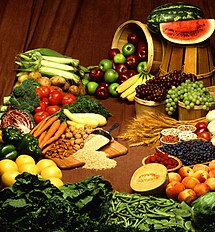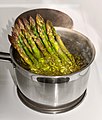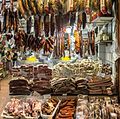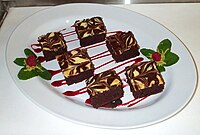Portal:Food
F o o d
A portal dedicated to food and foodways
Introduction


Food is any substance consumed by an organism for nutritional support. Food is usually of plant, animal, or fungal origin and contains essential nutrients such as carbohydrates, fats, proteins, vitamins, or minerals. The substance is ingested by an organism and assimilated by the organism's cells to provide energy, maintain life, or stimulate growth. Different species of animals have different feeding behaviours that satisfy the needs of their metabolisms and have evolved to fill a specific ecological niche within specific geographical contexts.
Omnivorous humans are highly adaptable and have adapted to obtain food in many different ecosystems. Humans generally use cooking to prepare food for consumption. The majority of the food energy required is supplied by the industrial food industry, which produces food through intensive agriculture and distributes it through complex food processing and food distribution systems. This system of conventional agriculture relies heavily on fossil fuels, which means that the food and agricultural systems are one of the major contributors to climate change, accounting for as much as 37% of total greenhouse gas emissions. (Full article...)
Cooking, also known as cookery or professionally as the culinary arts, is the art, science and craft of using heat to make food more palatable, digestible, nutritious, or safe. Cooking techniques and ingredients vary widely, from grilling food over an open fire, to using electric stoves, to baking in various types of ovens, reflecting local conditions. Cooking is an aspect of all human societies and a cultural universal.
Preparing food with heat or fire is an activity unique to humans. Archeological evidence of cooking fires from at least 300,000 years ago exists, but some estimate that humans started cooking up to 2 million years ago.
The expansion of agriculture, commerce, trade, and transportation between civilizations in different regions offered cooks many new ingredients. New inventions and technologies, such as the invention of pottery for holding and boiling of water, expanded cooking techniques. Some modern cooks apply advanced scientific techniques to food preparation to further enhance the flavor of the dish served. (Full article...)
A BLT is a type of sandwich, named for the initials of its primary ingredients, bacon, lettuce, and tomato. It can be made with varying recipes according to personal preference. Simple variants include using different types of lettuce or tomatoes, toasting or not, or adding mayonnaise. More pronounced variants can include using turkey bacon or tofu in place of bacon, removing the lettuce entirely, or adding other ingredients such as a fried egg, avocado, or sprouts. (Full article...)
Selected article –

Kobe beef (神戸ビーフ, Kōbe bīfu) is Wagyu beef from the Tajima strain of Japanese Black cattle, raised in Japan's Hyōgo Prefecture around Kobe city, according to rules set out by the Kobe Beef Marketing and Distribution Promotion Association. The meat is a delicacy, valued for its flavour, tenderness and fatty, well-marbled texture. Kobe beef can be prepared as steak, sukiyaki, shabu-shabu, sashimi, and teppanyaki. Within Japan, Kobe is one of the three Sandai Wagyū, the "three big beefs", along with Matsusaka beef and Ōmi beef or Yonezawa beef.
Kobe beef is also called Kōbe-niku (神戸肉, "Kobe meat"), Kōbe-gyū or Kōbe-ushi (神戸牛, "Kobe cattle") in Japanese. (Full article...)
Selected cuisine -

Filipino cuisine is composed of the cuisines of more than a hundred distinct ethnolinguistic groups found throughout the Philippine archipelago. A majority of mainstream Filipino dishes that compose Filipino cuisine are from the food traditions of various ethnolinguistic groups and tribes of the archipelago, including the Ilocano, Pangasinan, Kapampangan, Tagalog, Bicolano, Visayan, Chavacano, and Maranao ethnolinguistic groups. The dishes associated with these groups evolved over the centuries from a largely indigenous (largely Austronesian) base shared with maritime Southeast Asia with varied influences from Chinese, Spanish, and American cuisines, in line with the major waves of influence that had enriched the cultures of the archipelago, and adapted using indigenous ingredients to meet local preferences.
Dishes range from the very simple meal of fried salted fish and rice to curries, paellas, and cozidos of Iberian origin made for fiestas. Popular dishes include lechón (whole roasted pig), longganisa (Philippine sausage), tapa (cured beef), torta (omelette), adobo (vinegar and soy sauce-based stew), kaldereta (meat stewed in tomato sauce and liver paste), mechado (larded beef in soy and tomato sauce), pochero (beef and bananas in tomato sauce), afritada (chicken or beef and vegetables simmered in tomato sauce), kare-kare (oxtail and vegetables cooked in peanut sauce), pinakbet (kabocha squash, eggplant, beans, okra, bitter melon, and tomato stew flavored with shrimp paste), sinigang (meat or seafood with vegetables in sour broth), pancit (noodles), and lumpia (fresh or fried spring rolls). (Full article...)
Selected ingredient –
Worcestershire sauce or Worcester sauce (UK: /ˈwʊstər(ʃər)/ WUUST-ər(-shər)) is a fermented liquid condiment invented by pharmacists John Wheeley Lea and William Henry Perrins in the city of Worcester in Worcestershire, England, during the first half of the 19th century. The inventors went on to form the company Lea & Perrins.
Worcestershire sauce has been a generic term since 1876, when the English High Court of Justice ruled that Lea & Perrins did not own a trademark for the name "Worcestershire". (Full article...)
Selected recipe –
Brownies are typically eaten by hand or with utensils, and may be accompanied by a glass of milk, served warm with ice cream (à la mode), topped with whipped cream, or sprinkled with powdered sugar. In North America, they are common homemade treats and they are also popular in restaurants, ice cream parlors, and coffeehouses. (Full article...)
Pictured are Oatmeal Stout Brownies. This recipe, created by Joe Stutler, was a national finalist in the 2006 Cooking With Beer Challenge. The malt and oats in the beer enhance the flavor of the chocolate in these delicious brownies. Not overly cake-ey, not overly fudge-ey, the texture is nicely balanced. They're also decadently chocolate, and surprisingly light (thanks to the eggs). Great with a fruity beer, such as a lambic (Framboise, yum!).
Borscht (English: /ˈbɔːrʃt/ ) is a sour soup, made with meat stock, vegetables and seasonings, common in Eastern Europe and Northern Asia. In English, the word borscht is most often associated with the soup's variant of Ukrainian origin, made with red beetroots as one of the main ingredients, which give the dish its distinctive red color. The same name, however, is also used for a wide selection of sour-tasting soups without beetroots, such as sorrel-based green borscht, rye-based white borscht, and cabbage borscht.
Borscht derives from an ancient soup originally cooked from pickled stems, leaves and umbels of common hogweed (Heracleum sphondylium), an herbaceous plant growing in damp meadows, which lent the dish its Slavic name. With time, it evolved into a diverse array of tart soups, among which the Ukrainian beet-based red borscht has become the most popular. It is typically made by combining meat or bone stock with sautéed vegetables, which—as well as beetroots—usually include cabbage, carrots, onions, potatoes, and tomatoes. Depending on the recipe, borscht may include meat or fish, or be purely vegetarian; it may be served either hot or cold, and it may range from a hearty one-pot meal to a clear broth or a smooth drink. It is often served with smetana or sour cream, hard-boiled eggs or potatoes, but there exists an ample choice of more involved garnishes and side dishes, such as uszka or pampushky, that can be served with the soup. (Full article...)
Selected image –
Selected biography –
B. 10 August 1814 – d. 7 July 1890
Henri Nestlé (French pronunciation: [ɑ̃ʁi nɛsle]; born Heinrich Nestle, German: [ˈhaɪnrɪç ˈnɛstlə]; 10 August 1814 – 7 July 1890) was a German-Swiss confectioner and the founder of Nestlé, the world's largest food and beverage company. (Full article...)
Did you know (auto-generated) –

- ... that environmental activist Nigel Savage created Hazon after googling "Jewish food movement" and receiving zero search results?
- ... that an investigation found that most Mexican nutrition science students could not interpret a nutritional front-of-package labeling system correctly?
- ... that the Tapuae-o-Uenuku / Hector Mountains have been an important mahinga kai (food-gathering site) for the Māori for more than 600 years?
- ... that within the Armenian Rite, it takes 40 days and more than 40 flowers, herbs, and spices to create the chrism known as myron?
- ... that a two-year-old food bank contributed 150 semi-trucks of supplies to relief efforts for Hurricane Katrina?
- ... that the Ni'isjoohl totem pole was once fed a diet of vacuum-packed food?
More did you know –
Related portals
Food topics
The following are topics relating to food
Categories
Food list articles
- See also: Lists of foods and Category:Lists of drinks
The following are some Food list articles on Wikipedia:

- American cheeses
- Appellation d'Origine Contr�l�e cheeses
- Apple cultivars
- Bacon dishes
- Bacon substitutes
- Basil cultivars
- Breads
- Breakfast beverages
- Breakfast cereals
- Breakfast foods
- British cheeses
- Cakes
- Candies
- Cheeses
- Cheese soups
- Christmas dishes (list)
- Cocktails
- Cookies
- Dishes using coconut milk
- Diets
- Doughnut varieties
- Egg dishes
- Fermented soy products
- Food additives
- Food additives (Codex Alimentarius)
- Foods named after people
- French cheeses
- French dishes
- Fried dough foods
- Fruits
- List of hamburgers
- Herbs and spices
- Hors d'oeuvre
- Indian dishes
- Indian snack foods
- Indonesian dishes
- Italian dishes
- Japanese snacks
- Japanese dishes
- Jewish dishes
- Kebabs
- Korean beverages
- Mango cultivars
- Moroccan dishes
- Pasta
- Pastries
- Philippine snack food
- Pies, tarts and flans
- Poppy seed pastries and dishes
- Potato dishes
- Puddings
- Raw fish dishes
- Rice dishes
- Rolled foods
- Sauces
- Seafood
- Seeds
- Sandwiches
- Snack foods
- Soft drinks by country
- Soul foods and dishes
- Soups
- Stews
- Street foods
- Tapas
- Turkish dishes
- Twice-baked foods
- Vegetable oils
- Vegetables
- Vodkas
Things you can do
Related WikiProjects
| Parent project: WikiProject Food and Drink | |
| Child projects: | Task forces: (All inactive) |
|
|
| Related projects: | |
New articles
Rules | Match log | Results page (for watching) | Last updated: 2024-10-18 19:15 (UTC)
Note: The list display can now be customized by each user. See List display personalization for details.
- Annona squamosa (edit | talk | history | links | watch | logs | tools) by MPF (talk · contribs · new pages (1)) started on 2024-10-18, score: 20
- Third-pound burger (edit | talk | history | links | watch | logs | tools) by Sushidude21! (talk · contribs · new pages (4)) started on 2024-10-18, score: 20
- Tyromancy (edit | talk | history | links | watch | logs | tools) by Jonathan Deamer (talk · contribs · new pages (13)) started on 2024-10-17, score: 10
- Biscotti di San Martino (edit | talk | history | links | watch | logs | tools) by OppidumNissenae (talk · contribs · new pages (9)) started on 2024-10-17, score: 30
- Cassatella di Agira (edit | talk | history | links | watch | logs | tools) by OppidumNissenae (talk · contribs · new pages (9)) started on 2024-10-16, score: 30
- Ossa di morto (edit | talk | history | links | watch | logs | tools) by OppidumNissenae (talk · contribs · new pages (9)) started on 2024-10-15, score: 30
- Saratoga Water (edit | talk | history | links | watch | logs | tools) by Wil540 art (talk · contribs · new pages (20)) started on 2024-10-15, score: 20
- Flora Food Group (edit | talk | history | links | watch | logs | tools) by Cloudbound (talk · contribs · new pages (1)) started on 2024-10-14, score: 40
- Suguru Fukuda (edit | talk | history | links | watch | logs | tools) by TSUBAME98 (talk · contribs · new pages (7)) started on 2024-10-14, score: 10
- Kenya Suzuki (edit | talk | history | links | watch | logs | tools) by TSUBAME98 (talk · contribs · new pages (7)) started on 2024-10-14, score: 10
- Kōta Tatsu (edit | talk | history | links | watch | logs | tools) by TSUBAME98 (talk · contribs · new pages (7)) started on 2024-10-14, score: 10
- Takahide Ikeda (edit | talk | history | links | watch | logs | tools) by TSUBAME98 (talk · contribs · new pages (7)) started on 2024-10-14, score: 10
- Tsubasa Nabatame (edit | talk | history | links | watch | logs | tools) by TSUBAME98 (talk · contribs · new pages (7)) started on 2024-10-14, score: 10
- Shōma Kanemura (edit | talk | history | links | watch | logs | tools) by TSUBAME98 (talk · contribs · new pages (7)) started on 2024-10-14, score: 10
- Taiki Narama (edit | talk | history | links | watch | logs | tools) by TSUBAME98 (talk · contribs · new pages (7)) started on 2024-10-14, score: 10
- Sure Shot Burger (edit | talk | history | links | watch | logs | tools) by Another Believer (talk · contribs · new pages (70)) started on 2024-10-13, score: 20
- Guasteddra (edit | talk | history | links | watch | logs | tools) by OppidumNissenae (talk · contribs · new pages (9)) started on 2024-10-13, score: 30
- Wuliangye (spirit) (edit | talk | history | links | watch | logs | tools) by Dekimasu (talk · contribs · new pages (10)) started on 2024-10-13, score: 10
- Nagi Maehashi (edit | talk | history | links | watch | logs | tools) by Runciblehon (talk · contribs · new pages (1)) started on 2024-10-13, score: 10
- Pete's Hamburgers (edit | talk | history | links | watch | logs | tools) by Valereee (talk · contribs · new pages (12)) started on 2024-10-12, score: 10
- Smoked hamburger (edit | talk | history | links | watch | logs | tools) by Valereee (talk · contribs · new pages (12)) started on 2024-10-12, score: 20
- �ngel Castro (pitcher) (edit | talk | history | links | watch | logs | tools) by Tassedethe (talk · contribs · new pages (126)) started on 2024-10-12, score: 10
- Wayfinder Beer (edit | talk | history | links | watch | logs | tools) by Another Believer (talk · contribs · new pages (70)) started on 2024-10-12, score: 20
- Gu Lao Rou (edit | talk | history | links | watch | logs | tools) by Wdxnbb (talk · contribs · new pages (1)) started on 2024-10-12, score: 10
- Raviola di ricotta di Caltanissetta (edit | talk | history | links | watch | logs | tools) by OppidumNissenae (talk · contribs · new pages (9)) started on 2024-10-12, score: 30
- Cozze allo zafferano (edit | talk | history | links | watch | logs | tools) by JacktheBrown (talk · contribs · new pages (1)) started on 2024-10-12, score: 30
- Sprite cake (edit | talk | history | links | watch | logs | tools) by Hidden1234P (talk · contribs · new pages (6)) started on 2024-10-12, score: 10
- Roll� (edit | talk | history | links | watch | logs | tools) by OppidumNissenae (talk · contribs · new pages (9)) started on 2024-10-12, score: 30
- Wonderwood (edit | talk | history | links | watch | logs | tools) by Another Believer (talk · contribs · new pages (70)) started on 2024-10-11, score: 10
- Inger Thor�n (edit | talk | history | links | watch | logs | tools) by MumphingSquirrel (talk · contribs · new pages (6)) started on 2024-10-11, score: 10
- Mountain Dew Major Melon (edit | talk | history | links | watch | logs | tools) by MC-123 (talk · contribs · new pages (17)) started on 2024-10-11, score: 30
- Avena insularis (edit | talk | history | links | watch | logs | tools) by Bobby Cohn (talk · contribs · new pages (18)) started on 2024-10-11, score: 10
- Holy Spina (sweet) (edit | talk | history | links | watch | logs | tools) by OppidumNissenae (talk · contribs · new pages (9)) started on 2024-10-11, score: 30
- Nedelya (pastry shop) (edit | talk | history | links | watch | logs | tools) by SharkyIzrod (talk · contribs · new pages (7)) started on 2024-10-11, score: 30
- Pepitada (edit | talk | history | links | watch | logs | tools) by Mooonswimmer (talk · contribs · new pages (8)) started on 2024-10-11, score: 20
- Happy (restaurant) (edit | talk | history | links | watch | logs | tools) by SharkyIzrod (talk · contribs · new pages (7)) started on 2024-10-10, score: 20
- Pizza Lab (restaurant chain) (edit | talk | history | links | watch | logs | tools) by SharkyIzrod (talk · contribs · new pages (7)) started on 2024-10-10, score: 30
- Chocolate haupia pie (edit | talk | history | links | watch | logs | tools) by LittleT889 (talk · contribs · new pages (2)) started on 2024-10-10, score: 10
- Damola Adamolekun (edit | talk | history | links | watch | logs | tools) by Emmanuella643 (talk · contribs · new pages (11)) started on 2024-10-09, score: 10
- Lackersteen & Co (edit | talk | history | links | watch | logs | tools) by AlphaBetaGamma (talk · contribs · new pages (45)) started on 2024-10-09, score: 40
- Chicken tenders (edit | talk | history | links | watch | logs | tools) by The ed17 (talk · contribs · new pages (1)) started on 2024-10-09, score: 30
- Aladin Foods (edit | talk | history | links | watch | logs | tools) by SharkyIzrod (talk · contribs · new pages (7)) started on 2024-10-09, score: 30
- Nedd Brockmann (edit | talk | history | links | watch | logs | tools) by Pidzz (talk · contribs · new pages (6)) started on 2024-10-09, score: 10
- The Jacob Street Mystery (edit | talk | history | links | watch | logs | tools) by Lord Cornwallis (talk · contribs · new pages (124)) started on 2024-10-09, score: 10
- Suburban Curtains (edit | talk | history | links | watch | logs | tools) by BullDawg2021 (talk · contribs · new pages (10)) started on 2024-10-08, score: 10
- Highclere Castle Gin (edit | talk | history | links | watch | logs | tools) by AlphaBetaGamma (talk · contribs · new pages (45)) started on 2024-10-04, score: 10
- On Lok Yun (edit | talk | history | links | watch | logs | tools) by Phoebus 28 (talk · contribs · new pages (8)) started on 2024-10-08, score: 10
- Suriya Coffee (edit | talk | history | links | watch | logs | tools) by Phoebus 28 (talk · contribs · new pages (8)) started on 2024-10-08, score: 10
- The Workingman's Friend (edit | talk | history | links | watch | logs | tools) by Tduk (talk · contribs · new pages (1)) started on 2024-10-07, score: 10
- 50 Lan (edit | talk | history | links | watch | logs | tools) by Cunard (talk · contribs · new pages (3)) started on 2024-10-07, score: 20
- Lee Jun-young (edit | talk | history | links | watch | logs | tools) by Reading Beans (talk · contribs · new pages (78)) started on 2024-10-07, score: 10
- Calypso Lemonade (edit | talk | history | links | watch | logs | tools) by Bandit5568 (talk · contribs · new pages (2)) started on 2024-10-05, score: 20
- Boss (2013 soundtrack) (edit | talk | history | links | watch | logs | tools) by 223.178.82.150 (talk · contribs · new pages (2)) started on 2024-10-05, score: 10
- Healthy Eating in Schools (Wales) Measure 2009 (edit | talk | history | links | watch | logs | tools) by DotCoder (talk · contribs · new pages (114)) started on 2024-10-05, score: 20
- Angela Hui (edit | talk | history | links | watch | logs | tools) by Starklinson (talk · contribs · new pages (15)) started on 2024-10-05, score: 10
- Sushi Masuda (edit | talk | history | links | watch | logs | tools) by Another Believer (talk · contribs · new pages (70)) started on 2024-10-04, score: 10
- Mie Bangladesh (edit | talk | history | links | watch | logs | tools) by Heskyhatesdairy (talk · contribs · new pages (0)) started on 2024-10-03, score: 10
- Barry Crowson (edit | talk | history | links | watch | logs | tools) by Pyeongchang (talk · contribs · new pages (11)) started on 2024-10-04, score: 10
- Lizzie Collingham (edit | talk | history | links | watch | logs | tools) by Chiswick Chap (talk · contribs · new pages (5)) started on 2024-10-04, score: 10
- Feeding Britain in the Second World War (edit | talk | history | links | watch | logs | tools) by Smallchief (talk · contribs · new pages (1)) started on 2024-10-04, score: 10
- 2024 Tulkarm Camp airstrike (edit | talk | history | links | watch | logs | tools) by AnarchistHistory (talk · contribs · new pages (2)) started on 2024-10-04, score: 10
- IHasCupquake (edit | talk | history | links | watch | logs | tools) by Soulbust (talk · contribs · new pages (10)) started on 2024-10-01, score: 10
- Mountain Dew VooDew (edit | talk | history | links | watch | logs | tools) by MC-123 (talk · contribs · new pages (17)) started on 2024-10-01, score: 20
Associated Wikimedia
The following Wikimedia Foundation sister projects provide more on this subject:
-
Commons
Free media repository -
Wikibooks
Free textbooks and manuals -
Wikidata
Free knowledge base -
Wikinews
Free-content news -
Wikiquote
Collection of quotations -
Wikisource
Free-content library -
Wikiversity
Free learning tools -
Wiktionary
Dictionary and thesaurus

















































